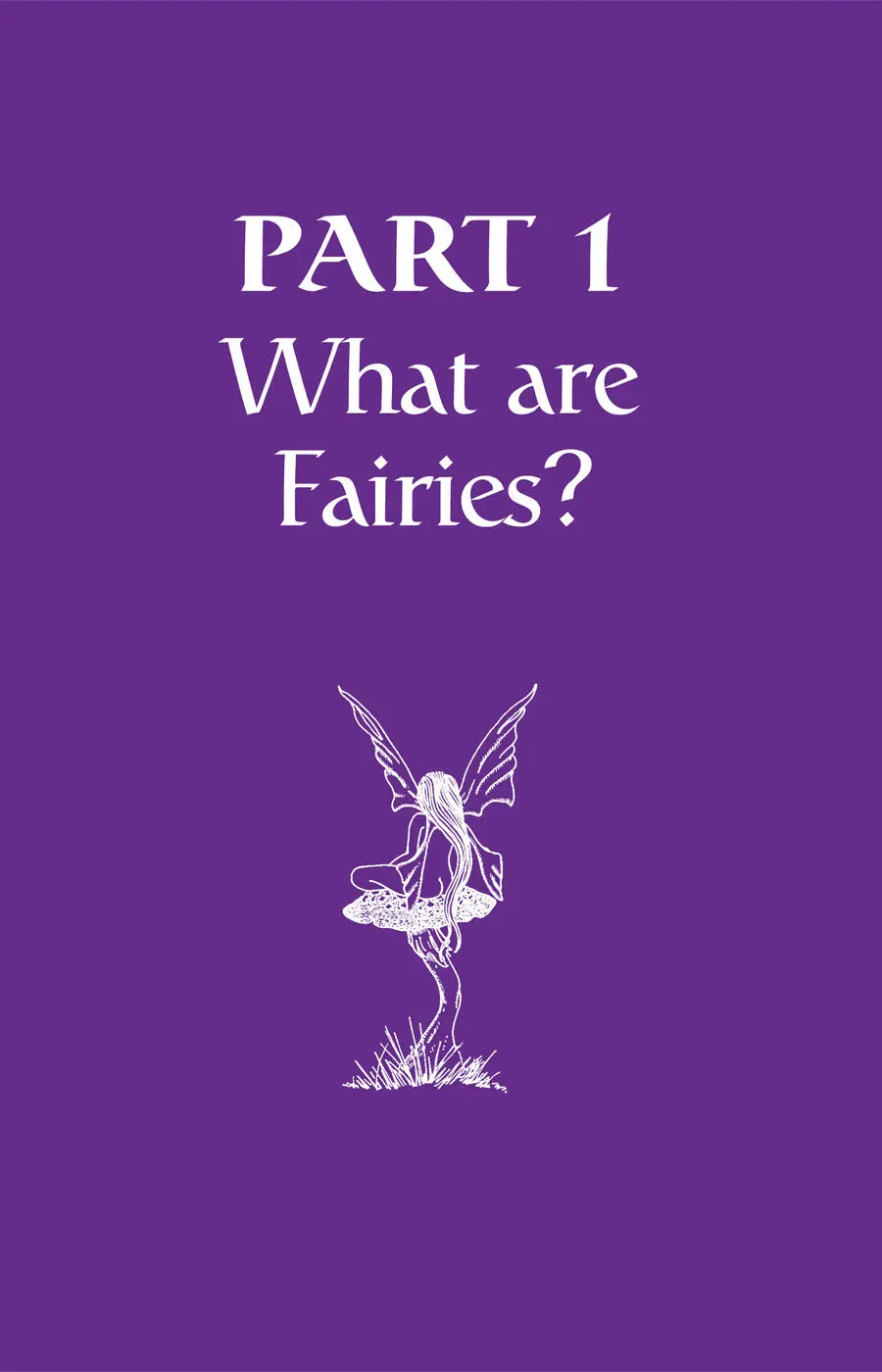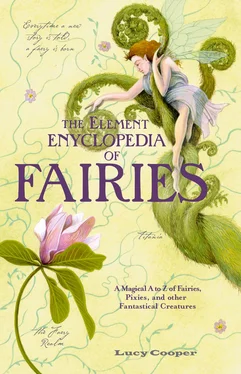Already we have glimpsed many fairy creatures and there is hardly a pair of wings in sight. The winged fairies of children’s picture books are a relatively new addition to the fairy world, popularized during the Victorian era. The fairies you will find here are drawn from the folk beliefs of cultures around the world.
The work of folklorist Katharine Briggs provides a rich store of reference for fairy lore of the British Isles, while Thomas Keightley’s The Fairy Mythology (1828) brings together fairy lore from many different cultures around the world. These, along with many other sources, have provided starting points for investigation. Where possible, the oldest sources of accounts have been tracked down. Material has been drawn from anthropological texts, journals, periodicals, encyclopedias and dictionaries of mythology, collections of folklore, folk tales, superstitions, customs, and letters.
In 1881, the Cornish folklorist Robert Hunt wrote that even then:
… old-world stories were perishing like shadows in the mist before the rising sun. Many wild tales which I heard in 1829 appear to have been lost in 1835 … I drank deeply from the stream of legendary lore which was at that time flowing, as a well of living waters … and longed to renew my acquaintance with the wild tales of Cornwall which had either terrified or amused me as a child.
How many more wild tales from around the globe must have been lost as the old stories were swept away by the march of progress? And yet the fairies are still with us. With a little digging, it is possible to unearth old tales and beliefs. In some places fairies still inhabit the here and now. Elsewhere the stream of legendary lore is buried deep underground and one must dig deep to find it. Yet still it flows.
Inevitably, there is not room here to include the many thousands of denizens of fairyland, and apologies are extended to those who do not appear between these pages. However, it is hoped that the fairies here, representing many cultures around the world, will spark interest for further exploration of the fairy realm.
As beliefs have passed down the generations through oral tradition and spread to different locations, fairy names have taken on the dialects of different places. This means there are often many spellings of the same name, none of which is “correct.” Here, effort has been made to list the most commonly used names, along with common alternative spellings.
The A–Z listings contain entries for hundreds and hundreds of individual fairies, alongside some of the folklorists and fairytale collectors, such as the Brothers Grimm, whose work has contributed to what we know about fairy lore today. Words in boldcross-reference related entries, allowing you to hopscotch your way through the world of fairy.
You’ll find more information on specific aspects of fairy lore in the various sections. “What are Fairies?”explores theories on the origins of fairies, from a conquered pygmy race to fallen angels.
Fairyland has always exerted an irresistible pull on humans and “Where is Fairyland?”delves into the realms of fairy. Here you will discover entrances to fairyland, but tread carefully, for the path is often beset with danger, and that glittering pile of fairy gold is likely to turn into a handful of withered leaves in the light of day. Yet those who approach fairyland with a pure heart might be rewarded with a peek behind the veil of the everyday at the curious wonders of the fairy realm.
Fairies are well known for their capricious nature. Those wishing to make their acquaintance would be wise to ensure they have a protective piece of iron in their pocket before peering through a self-bored stone or picking a fourleafed clover. “Connecting with Fairies” looks at traditions and customs concerned with seeing fairies—and how to ward off unwanted attention from pernicious or mischievous fairies. Here you will also find tales of fairy encounters, a calendar of the times of year when fairies are at their most active, and information on fairy music and art.
One of the most commonly held beliefs about fairies, still widespread today, is that they are nature spirits, identified with flowers, trees, lakes, rivers, mountains, and other features of the natural landscape. “Elementals and Flower
Fairies”traces ideas about the elements of nature, from the alchemist Paracelsus via the Theosophists to Mary Cicley Barker’s flower fairy illustrations. Here you will find a rich variety of fairies of the earth, water, fire, and air from cultures around the world, as well as flowers and trees of fairy lore.
From larger-than-life magical heroes of Celtic legend to Shakespeare’s Oberon and Titania and J. M. Barrie’s Tinkerbell, fairies have undergone many transformations through the ages. “Fairies in Literature and Legend”takes a look at the changing face of fairies in English literature, from the mouths of storytellers via the quills of poets and playwrights right up to the present, as well as flits through some of the earliest-recorded fairy tales, from The Thousand and One Nights of Arabia to those related in the fashionable French salons .
Are you ready to begin your adventure in fairyland? Pick an entry at random, follow the trail of breadcrumbs, and see where you end up. Be warned, though: many who enter the land of fairy are never quite the same afterward.
After two years immersed in the world of fairies while compiling Italian Folktales (1956), the Italian writer Italo Calvino wrote, “The world about me gradually took on the attributes of fairyland, where everything that happened was a spell or metamorphosis.”
Capricious, amusing, fearsome, and delightful, the topsy-turvy look beyond the surface, to rediscover the magical in the everyday and glimpse the extraordinary in the ordinary. Prepare to venture into the fairy realm, where nothing is ever quite as it seems …

Quite simply, the answer to this question will depend on whom you ask. It’s like the story of the lady and the vicar, viewing the moon through a telescope, who see two shapes inclined toward each other. “Methinks,” says the lady, “they are two fond lovers, meeting to pour forth their vows by earth-light.” “Not at all,” says the vicar, taking his turn at the glass, “they are the steeples of two neighboring churches.”
What is seen is often determined by who is doing the looking.
So, what are fairies? Memories of a conquered race of pygmy people? Feared and venerated spirits of ancestors? Remnants of ancient mythology? Nature spirits? Depending on whom you ask, fairies are bound up with all—or none—of these things.
Some folklorists and anthropologists, mostly nineteenth-century ones, have suggested that fairy beliefs sprang from memories of conquered races of dwarvish people who lived in caves or mounds and used flint arrows. Stories about fairies, according to this theory, were the result of a clash of cultures. In Britain, this race of small people was conquered by the ancestors of the modern British, who had iron weapons. The conquered people retreated to the hills, or were driven into remote areas such as mountains and swamps, as the larger, more powerful, better-armed race advanced. Some hold this to be why iron is still used as protection against pernicious fairies today.
John Webster, writing in the same era as Shakespeare, expressed a view that was popular at the time:
Читать дальше













